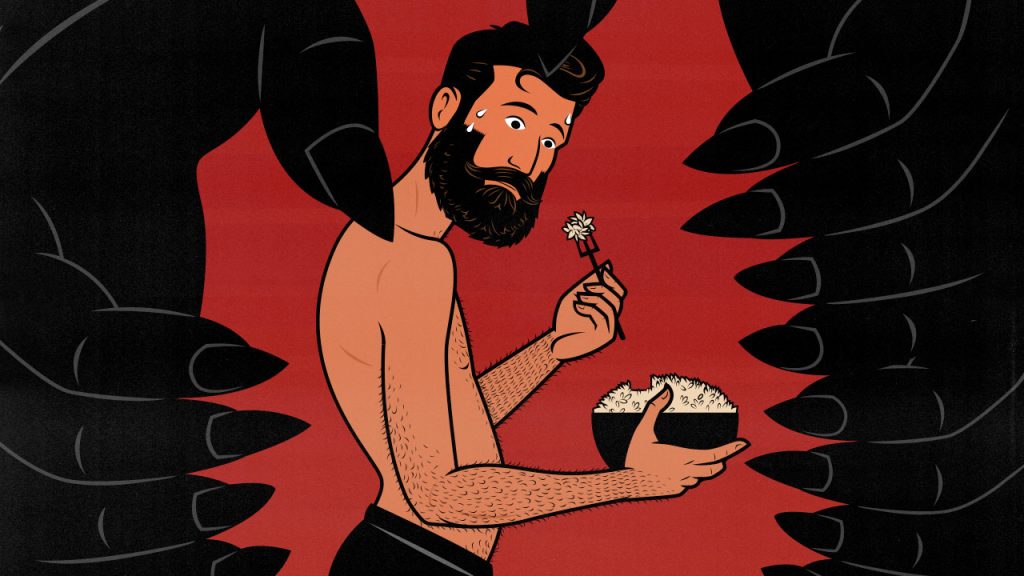
Can Bulking Cause Insulin Resistance & Diabetes?
Whenever we talk about how carbohydrates can be good for building muscle, we get comments from people worried that if they eat too many carbs, they’ll produce too much insulin, and their bodies will become desensitized to it, causing insulin resistance and potentially even leading to diabetes. Can that happen?
The other concern is that bulking means eating in a calorie surplus to gain weight intentionally. Can that calorie surplus cause insulin resistance?
I reached out to Dr. Karl Nadolsky, an endocrinologist who specializes in diseases like diabetes, and Danny Lennon, a nutritionist on the Advisory Board of the Sports Nutrition Association. I asked them if skinny and skinny-fat people should worry about eating too many carbs while bulking. Could that lead to insulin resistance and diabetes?
Their answers surprised me.
- Disclaimer & Introduction
- The Basics of Insulin Resistance
- The Impact of Genetics & Age
- How Diet Affects Insulin Resistance
- Can Skinny Guys Get Insulin Resistance?
- Big Muscles Reduce the Risk of Insulin Resistance
- Weight Training Reduces the Risk of Insulin Resistance
- What Body-Fat Percentage Puts You At Risk?
- Summary & Guidelines
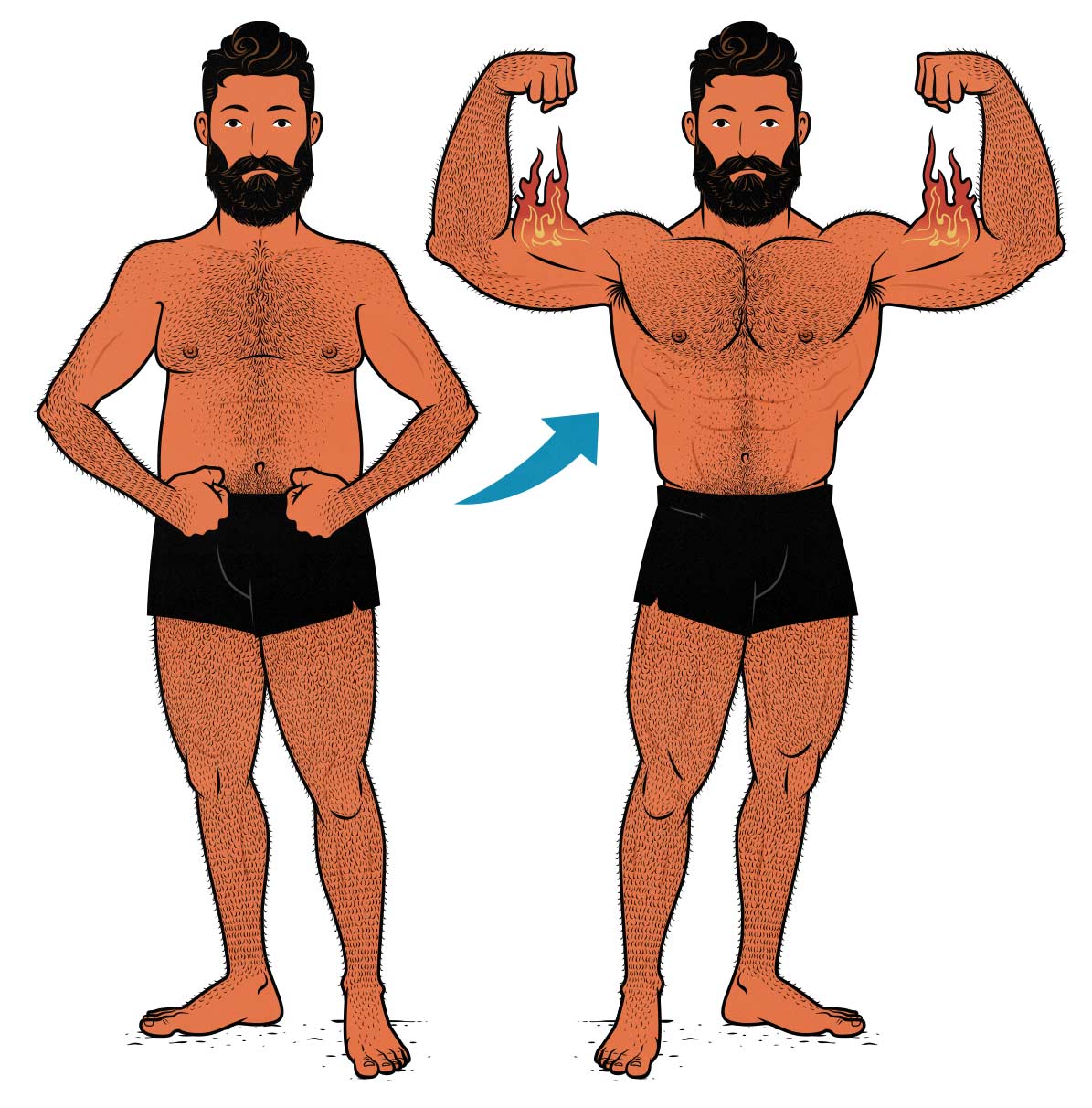
Disclaimer & Introduction
This is a site focused on muscle and fitness. Marco has a degree in health sciences (BHSc) and is a certified nutrition coach. Cassandra is a registered nutritionist. However, I’m always hesitant to venture outside of our specific area of expertise. That’s usually when people start giving bad information.
However, we routinely get questions about how carbs, bulking diets, and bulking up affect insulin resistance and diabetes risk. So, we reached out to the relevant experts: Dr. Karl Nadolsky, an endocrinologist, and Danny Lennon, a nutritionist on the Advisory Board of the Sports Nutrition Association. They’re qualified to speak about how exercise and nutrition affect our likelihood of developing insulin resistance and diabetes.
The Basics of Insulin Resistance
What Does Insulin Do?
To understand how bulking affects insulin, we first need to understand insulin:
- When you eat carbohydrates, you break them down into simple sugars, which are released into your bloodstream.
- When your pancreas detects rising blood sugar levels, it secretes insulin, which helps that sugar enter your cells, where you can use it for energy or store it as glycogen.
- When your blood sugar drops back to normal, your pancreas stops producing insulin, and everything is back at baseline.
That’s how insulin is supposed to work. But when someone has insulin resistance, their insulin stops working as efficiently, forcing them to produce more of it to get the job done. The ominous thing is, if it continues getting worse, it can eventually lead to type 2 diabetes, usually after around 10 years.
What Causes Insulin Resistance?
The next question is, what causes insulin resistance? The two main drivers seem to be inactivity and excess body fat, both of which can cause fat to accumulate in the pancreas and liver, interfering with insulin production and signalling (study, study).
That’s where the fear of carbohydrates comes in. When you eat more carbs, you release more sugar into your bloodstream, causing your pancreas to secrete more insulin. If your pancreas or liver isn’t working properly, that can cause issues.
How Carbs Affect Diabetes Risk
Imagine you have a broken leg. If you walk on that broken leg, it could make your injury worse, so it makes sense to take a break from walking on it. But if you don’t have a broken leg, then you don’t need to avoid walking on it. In fact, that would do more harm than good. You’d miss out on all the health benefits of walking.
Carbs aren’t so different. If you don’t have insulin resistance, there’s no reason to avoid carbs, allowing you to take advantage of the many health benefits of fruits, vegetables, whole grains, and legumes. This will also pump your muscles full of glycogen, making them bigger and fuller, improving your performance in the gym, and speeding up muscle growth (full explanation).
Even if you do have insulin resistance, the only known way to reverse it is to attack the root of the problem—to get rid of the extra fat impairing your pancreas and liver. To do that, you can use a combination of a calorie deficit, hypertrophy training, and, ideally, some cardio:
- The calorie deficit will help you lose weight.
- The resistance training will encourage muscle growth, ensuring that the weight you lose is pure fat. Resistance training also burns through glycogen, allowing you to benefit from a higher carb intake.
- People who do more exercise also tend to have proportionally less fat in their organs, even at the same overall body fat percentage.
Once you get the fat out of your organs, your pancreas and liver should begin working properly again, which will often get rid of insulin resistance. Or at least that’s my understanding of the situation. This is outside our area of expertise. So, I spoke with two experts: an endocrinologist and a nutritionist.
The Impact of Genetics & Age
The first expert I spoke with was Dr. Karl Nadolsky, an endocrinologist who specializes in diseases like diabetes. He’s also a fan of hypertrophy training, knows what bulking is, and understands how all of these pieces fit together.
He confirmed that eating carbs doesn’t cause insulin resistance. Rather, the two leading causes of insulin resistance are physical inactivity and high body fat levels. But he also pointed out that age and genetics can be factors, too.
So if someone is in their sixties, they’re skinny-fat, and diabetes runs in their family, they might want to focus more on lifting weights, doing cardio, and eating a nutritious diet, less on bulking up.
For the rest of us, we aren’t at particularly high risk to begin with, and lifting weights and building muscle will only drop our risks even further. Bulking tends to be good for us.
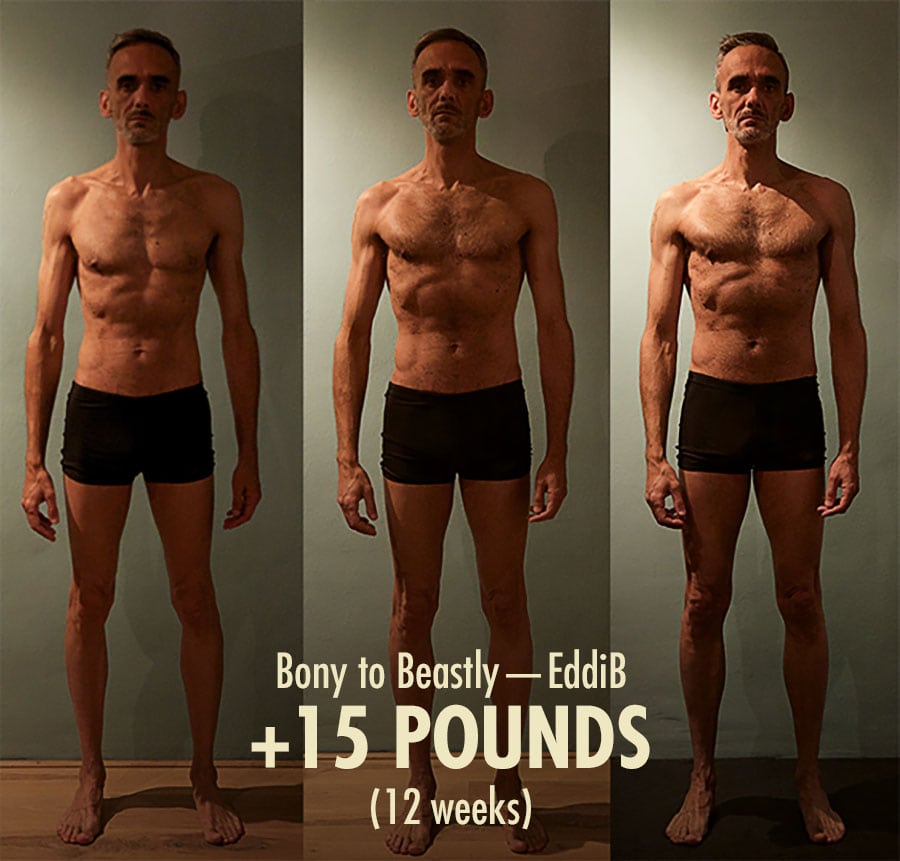
How Diet Affects Insulin Resistance
Next, I spoke with a nutritionist, Danny Lennon, a member of the Advisory Board of the Sports Nutrition Association. I knew about him because he hosts the Sigma Nutrition Podcast, which is widely regarded as being the most evidence-based nutrition podcast.
Danny told me that bulking up isn’t a problem, that lifting weights reduces our risk of developing insulin resistance, and that gaining muscle helps even more.
But, like Dr. Nadolsky, he pointed out that certain diets are better than others. He was more specific, too.
How Saturated Fat Affects Liver Fat
Danny Lennon told me that overconsuming saturated fat can cause extra fat storage in our organs, which can then contribute to insulin resistance, even when calorie intake is matched (study). For example, in a study by Bjermo and colleagues, the group given extra saturated fat increased their liver fat by 7%, whereas the group given extra polyunsaturated fat decreased their liver fat by 9% (study).
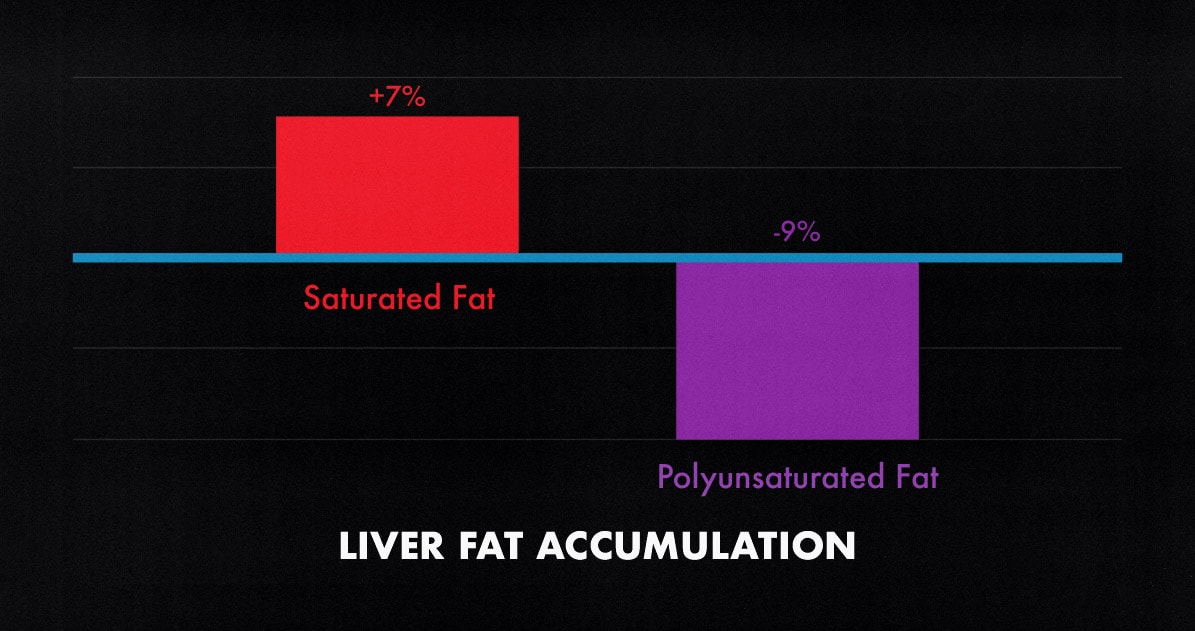
That surprised me. I knew saturated fat could affect our blood lipids, but I didn’t realize it was tied to insulin resistance, too. It even seems to negatively impact insulin sensitivity when there aren’t any measurable changes in visceral fat (study).
How Soluble Fibre Affects Insulin Resistance
On the bright side, there are also foods that seem to help. In particular, soluble fibre. It can bind to the saturated fat you eat and carry it through your digestive system, reducing the saturated fat in your blood. That’s the type of fibre found in foods like:
- Oats
- Peas
- Beans
- Lentils
- Chickpeas
- Apples
- Citrus Fruits
- Carrots
- Psyllium husk

How Sugar Affects Diabetes Risk
Excessive consumption of refined sugar is associated with insulin resistance. It’s not quite the same as saturated fat, though, and the difference is important.
Sugary foods and sodas taste good and aren’t very filling, so people who eat more sugar tend to eat more food and gain more weight. And if they’re sedentary, more of that weight is stored as fat, and more of that fat winds up in their organs.
If the refined sugar you eat isn’t making you fat, there’s less of a reason to worry. If you’re lean, there doesn’t seem to be a direct link between sugar consumption and insulin sensitivity (though this is debated). Still, most guidelines recommend limiting refined sugar to less than 10% of your total calories. I think that’s wise.
Can Skinny Guys Get Insulin Resistance?
Skinny people are at low risk of getting insulin resistance because we have relatively low levels of body fat. As a result, we’re less likely to have fat in our organs, and so we’re less likely to have issues with insulin production and signalling.
On the other hand, we also have low amounts of muscle mass. Some of us also lead sedentary lifestyles. So, if we lift weights, bulk up, and gain muscle mass, our risk will drop even lower.
Let’s talk about why.
Big Muscles Reduce the Risk of Insulin Resistance
One of the ways insulin can carry sugar out of our blood is by converting it into glycogen and storing it in our muscles. When we build bigger muscles, our muscles are able to store more glycogen, giving us a greater reservoir to store extra sugar, which is great for our health and performance.
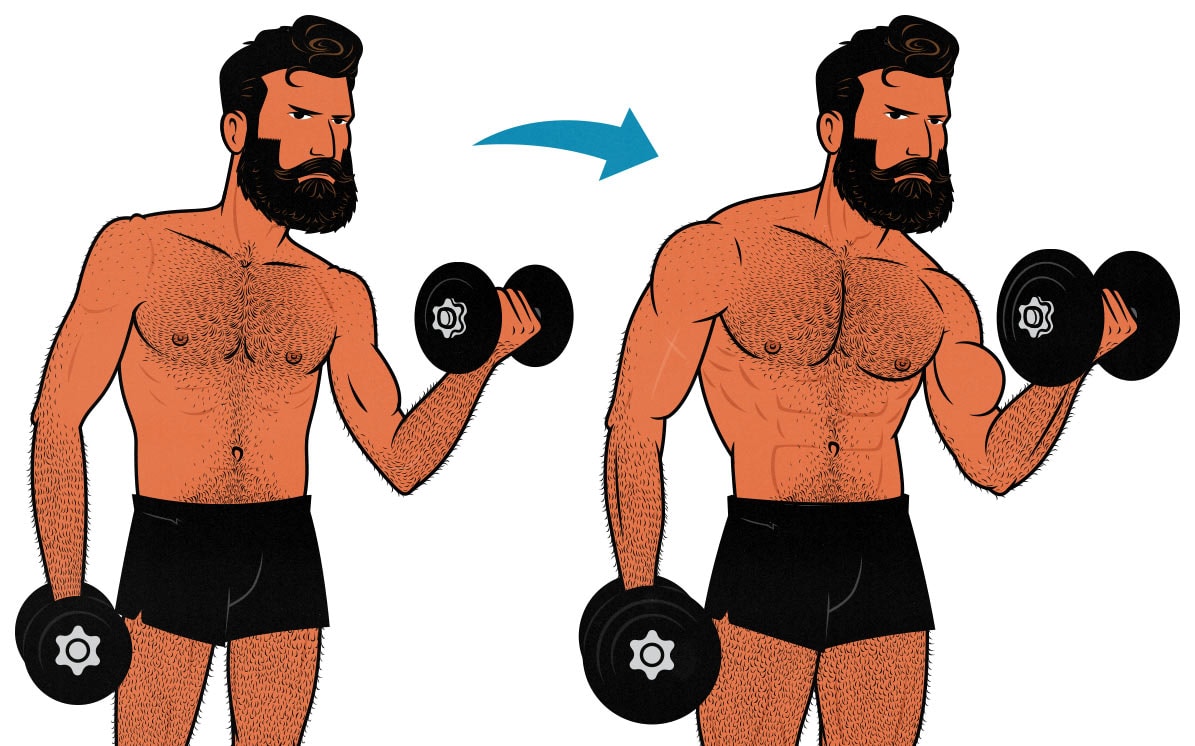
Weight Training Reduces the Risk of Insulin Resistance
Lifting weights reduces all-cause mortality and helps prevent insulin resistance (study). There are a couple of reasons for that. First, lifting weights is a form of exercise, and exercise causes us to store less of our fat viscerally—to store less of our fat in and around our organs. And so, like other forms of exercise, lifting weights reduces our risk of developing insulin resistance.
Second, when we lift weights, we burn through the glycogen in our muscles, allowing us to fill them back up with the sugar in our blood. Our muscles are reservoirs. Lifting weights drains those reservoirs, allowing us to fill them back up again. This is especially true when people do more reps per set and more sets per workout, burning through more glycogen. That makes hypertrophy training (aka bodybuilding) especially helpful.

What Body-Fat Percentage Puts You At Risk?
You can calculate your body fat percentage using this calculator, but the main measurement that matters for insulin resistance is your waist circumference. According to the National Institutes of Health, your risk of developing insulin resistance and diabetes only becomes significant once your waist circumference at belly button height creeps past 40 inches as a man or 35 inches as a woman (study).
If your waist is approaching 40 inches, we recommend cutting instead of bulking. That means eating in a calorie deficit and losing a little bit of weight every week. You can also eat a good diet, lift weights, do some cardio, and try to get enough sleep, all of which will help you burn proportionally more visceral fat. When your waist circumference drops below 36 inches, you can start emphasizing muscle growth.
Summary & Guidelines
Here’s what you need to know about how bulking influences insulin resistance and diabetes risk:
- The main drivers of insulin resistance are excess body fat and sedentariness, both of which cause visceral fat storage.
- Carbs don’t appear to cause diabetes. You can eat a high-carb bulking diet without fear of it causing problems. Even better if your diet is rich in fruits, vegetables, whole grains, nuts, seeds, and legumes, all of which are rich in fibre, driving your risk even lower.
- Saturated fat is linked with diabetes. Diets higher in saturated fat cause more visceral fat storage. We recommend bulking on a diet lower in saturated fat.
- Building muscle reduces your risk. Bigger muscles soak up more sugar, making it easier to manage blood sugar levels.
- Lifting weights reduces your risk. It burns through sugar, allowing you to benefit from eating more carbs.
- Living a healthy lifestyle reduces your risk. Doing cardio, lifting weights, going on walks, and being active all reduce your risk of developing insulin resistance. So does eating a balanced and nutritious diet that’s rich in fibre.
Overall, bulking should reduce your risk of developing diabetes, provided you do it properly. You’ll be lifting weights, increasing your activity levels, eating more nutritious foods, and building more muscle, all of which should reduce your risk.
We’ve spent over a decade helping 15,000 members bulk up. Most of them get 40–60% of their calories from carbohydrates. We’ve never heard of any of them—not even one—developing insulin resistance or diabetes while bulking.

Alright, that’s it for now. If you want more muscle-building information, we have a free muscle-building newsletter. If you want a customizable hypertrophy training program (and full guide), check out our Outlift Intermediate Bulking Program. Or, if you’re still new to bulking, try our Bony to Beastly (men’s) program or Bony to Bombshell (women’s) program. If you liked this article, I think you’d love our full programs.




This is a fantastic article for skinny people who want to get big. There is a tendency to overdo it and we need to be mindful of the media/fitness bloggers pushing saturated fat/carnivore diets.
Thank you, man!
Glad to see an article discussing insulin resistance. I want to make a few points from the low-carb perspective. First, I agree that eating carbs doesn’t cause insulin resistance in healthy people of normal weight. (I know there are camps saying that carbs cause insulin resistance regardless of context.)
When I looked at the studies cited in this article on saturated fat and insulin resistance, I noticed that they were on obese subjects. In Frankenburg et al. and Luukkonen et al., these obese subjects were given extra calories from fat. In those studies, fat and carbs were the largest macronutrients, and protein the lowest. In the Luukonen paper in the supplemental materials, I see that the saturated fat group lowered their protein from 20% to 15%.
The “High Fat Diet” from Frankenburg et al. was 55% fat, 27% carbs, and 18% protein, so again fat and carbs were the largest macros. “Hight Fat Diet” in the literature usually means a mixed diet containing carbs with extra fat added in; it doesn’t generalize to low-carb or ketogenic diets where the macros are fat > protein > carbs.
What I see in this papers is the combination of fat and carbs causing insulin resistance in obese subjects. Fat and carbs is the combination found in junk food. This could also be called “energy toxicity.” Could it be that saturated fat causes more insulin resistance in the setting of energy toxicity than other fats in obese subjects? Perhaps, but we are still talking about a setting of unhealthy diets. I am reluctant to generalize from these results to the idea that saturated fat causes insulin resistance across the board, even in slim subjects eating > 20% protein.
In the Luukkonen paper, they added 1000 calories of saturated fat, which is not something that any of your students would do when bulking. Adding pure energy to get to a 1000 calorie surplus is not a good idea. (Yes, I know there were fads in the past of keto people adding pure butter or coconut oil to their coffee, though I think most of the low-carb world now admits that this isn’t healthy.)
We don’t want to condemn carbs as causing insulin resistance in healthy subjects, so we should be cautious to condemn saturated fat as causing insulin resistance, when the evidence we have is about obese subjects eating energy-toxic, low-protein diets. In both these cases, it may be that carbs or saturated fat are being blamed, when the real problem is the combination of carbs and fats, energy toxicity, and protein/energy imbalance.
Because the research on saturated fat is done on people with mixed diets who are still eating carbs as their second-largest macro, this fails to isolate the effect of saturated fat on its own, separate from carbs. So I see that you are tackling this question with the studies that presently exist, but the right type of studies on saturated fat in the context of low-carb haven’t been done to my knowledge.
The metabolic effect of saturated fat in the context of a well-designed low-carb or ketogenic diet with at least 1g protein / lb of body weight might be different, especially in skinny subjects.
Another point I will make is that there are other things which can cause insulin resistance to watch out for, like corticosteroids (cortico-, not anabolic), which can be used to treat injuries, sinusitis, or autoimmune disease. Various other medications can also cause insulin resistance.
Hey Rick,
I agree with a lot of what you’re saying. After talking with these two experts and browsing through the research, it seems the two main causes of insulin resistance are overeating and sedentariness. Saturated fat appears to play into this, at least based on Danny Lennon’s take on the available research, but it’s easy to imagine someone lean and active who wouldn’t store excess visceral fat even when eating a diet higher in saturated fat.
Did you look at the Bjermo study? They tried to keep the macros the same, giving some participants scones made with butter (higher in saturated fat), the others scones made with sunflower oil (higher in polyunsaturated fat). Those eating the scones made with sunflower oil had better outcomes. I like studies like this one because it mimics what you’d see in the real world. You can imagine someone being told to limit their intake of saturated fat, and thus switching from one brand of scone to another, along with a few other swaps. Still, I agree that we’d likely see even better outcomes if they swapped out the processed scones for something more nutritious.
I’m not against low-carb diets, and I’m sorry if this article comes across that way. Someone could eat tons of fatty fish, nuts, seeds, olive oil, avocados, and so on, getting plenty of calories from fat. They could also favour fibrous veggies, keeping their carb intake very low. That lines up perfectly well with the recommendations for avoiding insulin resistance. It also lines up with the guidelines I’ve seen for eating a nutritious low-carb diet.
Plus, different people are different. If your diet is working for you, that’s perfect. I won’t try to convince you to change it. We work with clients who follow all kinds of different diets.
(Medication is well outside my area of expertise.)
Hi Shane, don’t worry, the article isn’t coming across as against low-carb diets. The question I wanted to raise is about the status of saturated fat. From looking at these papers on saturated fat, some people could get the impression that saturated fat is generally harmful and causes insulin resistance. I want to urge caution about anyone coming away with the message that saturated fat is bad regardless of context (note: I’m not saying that this is your position).
In the Frankenburg and Luukkonen papers, the subjects were adding saturated to a mixed diet, with fat as the highest macro, followed by carbs, with protein as the lowest macro. I have objected to the generalizability of these papers because they involved overfeeding a lot of extra energy to obese subjects eating low protein.
You also mention the Bjermo paper, where they fed subjects scones with sunflower oil (for n-6 PUFA / linoleic acid) or butter (for saturated fat), and the saturated fat condition showed a higher increase in insulin. Unlike the other two studies, this wasn’t intended as an overfeeding study.
I agree with your observation that eating scones slathered in sunflower oil or butter is not a healthy diet. I will also point out that the saturated fat condition was eating more fat then the PUFA condition.
Though there is still a valid question: if an unhealthy vegetable oil diet increases insulin less than an unhealthy saturated fat diet, does it isolate the effect of saturated fat and prove that saturated fat raises insulin in general? I would suggest caution on such a conclusion.
In other contexts, like ketogenic diets, saturated fat can be high but insulin levels can drop. Noakes et al. compared a Very Low Fat Diet, a High Unsaturated Fat Diet, and a Very Low Carb Diet: https://www.ncbi.nlm.nih.gov/pmc/articles/PMC1368980/
Here were the macros: “Very Low Fat (VLF) (CHO:Fat:Protein; %SF = 70:10:20; 3%), High Unsaturated Fat (HUF) = (50:30:20; 6%), VLCARB (4:61:35; 20%)”
The results: “VLCARB lowered fasting insulin 33% compared to a 19% fall on HUF and no change on VLF (P < 0.001). The VLCARB meal also provoked significantly lower post prandial glucose and insulin responses than the VLF and HUF meals."
The Very Low Carb condition was highest in saturated fat (20%). If saturated fat was generally harmful across the board, we would expect that saturated fat condition to have less improvement to insulin levels, but instead, the very low carb saturated fat diet had the greatest improvement to insulin levels. It's also notable that the Very Low Carb condition was eating the highest protein percentage, and had the least energy from fat and carbs.
Of course, this paper doesn't quite tell us what would happen to skinny subjects bulking (it's about overweight subjects cutting). But it does show that saturated fat isn't automatically bad. Saturated fat could be metabolized differently when it's not accompanied by carbs. Maybe it's not saturated fat that's bad, maybe it's saturated fat + carbs that is the problem in the setting of energy toxicity.
The difficulty here is that we don't have the sort of data that we really want (studies of different fats in non-overweight subjects bulking, who are eating at least 20% protein, to see what raises insulin). I think it's going to be a lot harder for skinny guys to put themselves into energy toxicity even while bulking, because the metabolism catches up.
Anecdotally, there are lots of people in the low-carb and keto world eating lots of saturated fat who claim that their fasting insulin levels are low.
I agree with your point that it's possible to do a low-carb diet that deemphasizes saturated fat.
There are other reasons for some people to be concerned about saturated fat, such as raising LDL cholesterol, which are a different subject. Conversely, when replacing saturated fat with n-6 PUFA linoleic acid, as in the Bjermo paper, there is a whole camp taking the position that linoleic acid is harmful in excess (which is also another subject).
Another comment is that those who are concerned about diabetes from bulking could use a fingerprick blood glucose meter to track whether their blood sugar is rising, or request a fasting insulin test from their doctor.
I wasn’t trying to say that scones cannot be part of a good diet, just that the average person already eats too much processed food, so you might imagine even more benefits if they swapped out scones with a more nutritious whole food. If someone already eats well, a nutritious bulking diet probably has room for some scones. You could make the same argument for foods containing saturated fat. However, note that the people eating the scones with polyunsaturated fat saw reductions in liver fat storage. It wasn’t just less harm, it was a benefit.
I’m not sure that foods which raise insulin are the problem. The way it was explained to me, the issue is whether our bodies can properly handle the amount of insulin we’re producing, which is influenced by visceral fat storage, activity levels, muscularity, genetics, and so on. If I’m understanding it correctly, we don’t need to measure how much our insulin is rising in response to foods, just that our bodies are able to bring those levels back down. I believe that’s why doctors look at fasting glucose levels.
In studies comparing low-carb diets against higher-carb diets, we’re talking about more than just saturated fat. I’ll agree with you that there’s more than just saturated fat at play here. Saturated fat is one of several factors, and is relatively small part of the article, given much less weight than larger factors like overeating and sedentariness.
I’m not familiar with the term “energy toxicity.” Is it synonymous overeating? According to the experts I spoke with and the research I’ve read, overeating is one of the two main drivers of insulin resistance, along with sedentariness.
Even if I wanted to, I can’t really debate you on this. I didn’t know of the connection between saturated fat and insulin resistance until I spoke with Danny Lennon. His understanding of the research is that there’s a connection, and he referenced a few studies. I used one of the studies he referenced as an example. Unfortunately, as loath as I am to say this, given how much much I love a good argument, the longer I speak about this, the greater the risk of me saying something very stupid.
I’ll add that Danny Lennon has spoken with Dr. Nicola Guess, RD, PhD, a few times. She’s one of the top experts on the prevention and management of type 2 diabetes. I believe she’s a fan of low-carb diets.
The subjects in the study did see reductions in liver fat on the PUFA diet, yes. There are other health concerns about PUFAs, though that’s another topic.
Agreed that monitoring fasting glucose levels is sufficient in most cases and monitoring fasting insulin isn’t usually needed.
“Energy toxicity” is a term used by the folks who are interested in protein leverage, such as Dr. Ted Naiman: https://twitter.com/tednaiman/status/1224609159762432001
This camp believes that excess non-protein calories (either from carbs or fat or both) are the source of metabolic problems due to being low in satiety. Non-protein calories are termed “energy.” So the enemy for metabolic health isn’t carbs or fat specifically, but too much of either of them combined.
Ted Naiman also has a cool transformation because he used to be skinny.
“Energy toxicity” would be from overeating, though specifically from overeating carbs and fat. “Energy toxicity” can also be an internal state due to insulin resistance, where the fat cells cannot take more fat, and dietary fat and glucose sit around in the bloodstream without being metabolized. Excess gluconeogenesis as seen in diabetes would be another example.
Oh, cool! That’s a great transformation.
It looks like people aren’t entirely clear what energy toxicity means in that tweet, either. I see Kevin Hall, a prominent nutrition researcher, asking for a definition.
At a glance, the model seems overly simplistic. It neglects so many other factors that contribute to overeating: sedentariness, lack of exercise, lack of muscle stimulation, hyper-palatable ultra-processed foods, food being so easily accessible, people snacking when watching TV, and so on. Not eating enough protein might fit in there, too. So would not eating enough fibre, or not eating enough nutritious food in general. Once we account for these other factors, I’m not sure what’s left. It starts to look like the generally agreed upon understanding of the obesity epidemic, which is good and helpful but not novel.
Again, though, I don’t know very much about this. I’m just speaking my initial skepticism out loud. I can keep an eye on this. If the research seems to be bearing out, I can ask some relevant experts and write an article on it.
Most controversial new ideas are wrong, but the ones that aren’t can advance the entire field. Perhaps this is one of those.
Hey great article!
Even if we always easily keep our waist under 40 inches and are exercising as reccommended. Would you say the upper limit of saturated fat should always be less then 10% (assuming no genetic or family history issues of course)? Or would our upper limit depend on our level of leanness and whether or not we are cutting, bulking, or at maintenance?
Maybe up to 14% only if we are lean and cutting, but less then 10% if we are bulking and approaching a 36 inch waist?
I get my saturated fat from milk, cheese, extra lean ground beef, and eggs so I think these are the safer unprocessed choices.
Thanks!
Hey Rob, thank you!
I have a similar understanding as you. The milk fat globules in milk, yogurt, and cheese (but not butter) help to mitigate the negative effects of saturated fat. The saturated fat in chocolate doesn’t seem to be much of a problem, either. Extra-lean ground beef has almost all of the fat trimmed away. It’s more the butter, palm oil, coconut oil, and fatty cuts of meat I try to limit. And then I also try to eat plenty of fibre, which also seems to help.
I’m less sure about exactly what percentage to aim for or how energy balance would influence that. I don’t have much to add there. Personally, I try to keep it low either way, but not obsessively so, and making allowances for nutritious foods that contain somewhat higher levels of saturated fat (like cheese and dark chocolate).
Great article!
Just when I needed to deal with my fear of eating to much sugar and preventing future problems with diabetes.
SATURATED FAT
“overconsuming saturated fat can cause extra fat storage in our organs, which can then contribute to insulin resistance, even when calorie intake is matched”
I did not know this. Will track my calories to see how much saturated fat I eat in my diet.
Thank you 🙂
Thanks, Daniel!
I didn’t know that, either. I had heard of how saturated fat affects blood lipids but never of how it can affect fat storage.
Hi Shane.
This one is a bit off topic but still relevant to eating for muscle growth. I’ve done the B2B program a number of times and am currently doing the Outlift program (both of which have been/are great). My family has somewhat competing eating goals – my wife is trying avoid gaining weight and prefers mainly vegetarian meals and my oldest son is full vegetarian. That’s not a real problem and I know plenty of plant foods that have plenty of protein but you do have to work a bit harder at it.
Because of the above, I try to plan meals that have maximum protein for gym days – sometimes frying a side of chicken for those that want it etc. That got me wondering about the most effective window for consuming protein and I found several articles, including this one:
https://pubmed.ncbi.nlm.nih.gov/8563679/#:~:text=It%20is%20concluded%20that%20following,has%20almost%20returned%20to%20baseline.
The study found that muscle protein synthesis increases by about 50% 4 hours after resistance training and by 109% 24 hours afterwards then drops to 14% above normal after 36 hours.
Given the cost of protein and other factors like fitting in with other family requirements/ desires, what do you think about specifically targeting that 24 hour window and not worrying too much after that until the next workout? I even wonder about extending the thinking to bulking – only eating big within 24 hours of training and then taking it easy to avoid putting on fat (I normally train three times per week).
Very interested in your thoughts. I feel like there could be an article in there somewhere (although I’m sure you have a long list of ideas already).
Thanks a lot
Hey Andrew, that’s awesome! So glad you’re liking the programs.
That’s a tricky question. We’ve written about how many days of muscle growth a workout stimulates here, going over some of that research, like the study you’ve linked. You’re right that muscle-protein synthesis spikes right after training and then steadily declines thereafter, but it’s less clear if calorie cycling, carb cycling, or protein cycling helps. You’d think that it would. It makes logical sense. But most studies suggest that it probably doesn’t.
I think if you’ve trained rigorously within the past 2–3 days, you’re safe to eat a big bulking diet. If you’re been away from the gym for longer than that, I’d shift down to a maintenance calorie intake.
I’m not sure how much protein you’re eating. You “only” need about 0.7 grams of protein per pound bodyweight per day to maximize your rate of muscle growth. Most lifters round that up to a full gram per pound, but you don’t need to.
On the other hand, most research on calorie cycling doesn’t find a disadvantage, either. It seems to be just as effective as eating a steadier diet. Your plan will probably work quite well 🙂
Thanks for that. I think I did read that article but with a different focus at the time – literally thinking about how often to train. Even if protein/calorie etc cycling isn’t beneficial it’s good news if it’s not detrimental. I can comfortably get 70g protein from breakfast, lunch and snacks so need another 50g from dinner to get to the 0.7g/lbl target. That’s achievable but probably not just from rice and veges :).
Cheers,
Andrew
As a med student and a bodybuilding enthusiast I really appreciate the effort made writing this article. Very helpful and scientifically on point.
My pleasure, man! That means a lot coming from you. So glad you liked it.